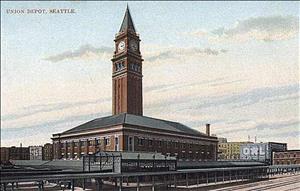On March 29, 1909, railroad workers lay the last rail of the Chicago, Milwaukee & Puget Sound Railway's line (later named the Chicago, Milwaukee & St. Paul Railway) at Snoqualmie Pass, just in time to carry passengers from Eastern Washington to Seattle for the opening of the Alaska-Yukon-Pacific Exposition. Nearly four million fairgoers will visit the exposition, a world's fair located on the University of Washington campus that will run from June 1, 1909 to October 16, 1909. Fairgoers traveling to Seattle from around the state, country, and world, will mostly arrive by train or ship, since there are few roads crossing the mountains.
Arriving at the Country's Far Corner
With the completion of the Chicago, Milwaukee & Puget Sound's line to Seattle, three railroads connected Seattle with Eastern Washington. Two of these, the Northern Pacific Railway (later railroad) and the Great Northern Railway, crossed the continent to the East Coast.
The Southern Pacific Railroad and the Union Pacific Railroad also reached Seattle, with trains to Oregon, California, and points to the southeast, including Kansas City. The Columbia and Puget Sound Railroad ran north from Portland and the Soo-Seattle-Pacific line of the Canadian Pacific Railway ran south from Canada.
Six ocean-going steamship companies brought visitors from Oregon, California, Scandinavia, and Asia. Numerous local steamship companies served communities around Lake Washington, Lake Union, and Puget Sound. The Seattle-Tacoma Interurban Railway provided service between Seattle and Tacoma, stopping at the numerous small towns along the way.
In 1909 Seattle was at the far corner of the country, reachable only by the transcontinental railroads and passenger steamships that served the West Coast in the absence of the interstate freeways or even state highways. Military roads and other local roads connected communities in Washington, but these were often muddy and impassable. Trips that take hours today by car took days by horse and wagon, if the wagon could traverse the rough road at all. Newly introduced automobiles, although faster than horse-drawn wagons, struggled in the difficult road conditions and the numbers of cars and trucks on Washington road remained small until the 1920s.
Getting to the Fair
Washingtonians came to the fair in droves and many of them took trains or the steamships on the lakes and Puget Sound that were so numerous that people called them the Mosquito Fleet. Daily (and some more frequently) trains from Spokane, Grays Harbor, Enumclaw, Tacoma, Bellingham, North Bend, Everett, Ellensburg, and points along the way afforded visitors a convenient means of getting to the fair. Steamships that carried passengers around Puget Sound, Lake Washington, and Lake Union operated numerous daily roundtrip services. The lines that traversed the lakes could bring visitors up to the lakefront gates of the exposition. The Seattle-Tacoma Interurban Railway, an electric line, ran between downtown Seattle and downtown Tacoma, stopping at small towns along the way.
Visitors from the East Coast and Europe could come to Seattle by sea, but the trip involved going around Cape Horn, at the southern tip of South America. The Panama Canal would not be completed for five more years. Thus, most westbound travelers boarded trains to Seattle. The Northern Pacific Railway and Great Northern Railway offered the fastest route, across the northern Great Plains. For travelers from the South and Southwest, connections could be made via the Union Pacific Railroad and the Southern Pacific Railroad. According to statistics compiled by the Seattle Chamber of Commerce after the exposition, the vast majority of travelers, over one million of them, came by rail.
The coastwise passenger steamship lines carried far fewer visitors in 1909 than the railroads, but still brought thousands to the city. Several lines, such as the Alaska Pacific Steamship Company and the Pacific Coast Steamship Company, operated routes from Alaska, Oregon, and California.
To reach Seattle from Asia, travelers could sail from Hong Kong, several Japanese ports, and Honolulu on the Nippon Yusen Kaisha (NYK) line. NYK passenger service to Seattle had begun in 1896 in cooperation with James J. Hill's Great Northern Railway, which had recently completed its transcontinental line to Seattle. Transpacific service could also be accessed through California ports.
Not surprisingly, considering Seattle's large Scandinavian immigrant population, the Scandinavian-American Line offered the only direct, non-Asian foreign passenger line. About once a week, a ship sailed between Seattle and Scandinavia, making stops in Norway, Sweden, and Denmark.
Closer to home, Canadian visitors to Seattle had a number of options for travel. They could board daily trains on the Canadian Pacific Railway's Soo-Pacific line, the Great Northern Railway, or the Northern Pacific Railway. By sea, they could take a steamship run by the Canadian Pacific Railway and the Puget Sound Navigation Company.
Within a few decades the automobile, better roads, and airplanes would put these modes of transportation in decline. In 1909, however, they served Seattle well by bringing the world to our doorstep.

